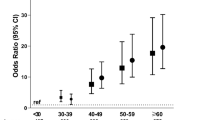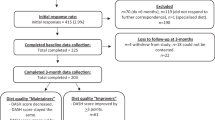Abstract
Individuals labelled as having hypertension tend to report poor self-rated health (SRH), but it is unclear whether this association is independent of actual hypertension, socioeconomic status and adiposity, and extends across racial and ethnic groups. In a cross-sectional study we compared hypertensive and normotensive individuals (N=19 057) who varied in whether they had ever been labelled hypertensive. Blood pressure was measured in participants' homes and mobile examination centres in the United States as part of the Third National Health and Nutrition Examination Survey, 1988–1994. The main outcome measure was global SRH. Hypertensive labelling was associated with poorer SRH and was independent of established SRH predictors, antihypertensive medication use, body mass index, and hypertension status (adjusted odds ratio (OR)=1.79, 95% confidence interval (CI), 1.61–1.99). Hypertension was also associated with poorer SRH (OR=1.26; 95% CI 1.09–1.46) but this association was eliminated by adjustment for hypertensive labelling (OR 1.06; 95% CI 0.92–1.22). These effects were consistent across non-Hispanic white, non-Hispanic black, and Hispanic subgroups. Individuals labelled hypertensive are more likely to have lower SRH and this labelling effect predominates over that of actual hypertension. Public health efforts to increase the number of individuals screened for high blood pressure may successfully detect the presence of hypertension but may also reduce health-related quality of life as measured by global SRH.
This is a preview of subscription content, access via your institution
Access options
Subscribe to this journal
Receive 12 digital issues and online access to articles
$119.00 per year
only $9.92 per issue
Buy this article
- Purchase on Springer Link
- Instant access to full article PDF
Prices may be subject to local taxes which are calculated during checkout


Similar content being viewed by others
References
Chobanian AV, Bakris GL, Black HR, Cushman WC, Green LA, Izzo Jr JL et al. The Seventh Report of the Joint National Committee on Prevention, Detection, Evaluation, and Treatment of High Blood Pressure: the JNC 7 report. JAMA 2003; 289: 2560–2572.
Fields LE, Burt VL, Cutler JA, Hughes J, Roccella EJ, Sorlie P . The burden of adult hypertension in the United States 1999 to 2000: a rising tide. Hypertension 2004; 44: 398–404.
Hajjar I, Kotchen TA . Trends in prevalence, awareness, treatment, and control of hypertension in the United States, 1988–2000. JAMA 2003; 290: 199–206.
US Department of Health and Human Services. Healthy People 2010: Understanding and Improving Health (2nd edn). US Government Printing Office: Washington, DC, 2000.
Rudd P, Price MG, Graham LE, Beilstein BA, Tarbell SJ, Bacchetti P et al. Consequences of worksite hypertension screening. Changes in absenteeism. Hypertension 1987; 10: 425–436.
Melamed S, Froom P, Green MS . Hypertension and sickness absence: the role of perceived symptoms. J Behav Med 1997; 20: 473–487.
Haynes RB, Sackett DL, Taylor DW, Gibson ES, Johnson AL . Increased absenteeism from work after detection and labeling of hypertensive patients. N Engl J Med 1978; 299: 741–744.
Bardage C, Isacson DG . Hypertension and health-related quality of life. An epidemiological study in Sweden. J Clin Epidemiol 2001; 54: 172–181.
Bloom JR, Monterossa S . Hypertension labeling and sense of well-being. Am J Public Health 1981; 71: 1228–1232.
Erickson SR, Williams BC, Gruppen LD . Perceived symptoms and health-related quality of life reported by uncomplicated hypertensive patients compared to normal controls. J Hum Hypertens 2001; 15: 539–548.
Mena-Martin FJ, Martin-Escudero JC, Simal-Blanco F, Carretero-Ares JL, Arzua-Mouronte D, Herreros-Fernandez V . Health-related quality of life of subjects with known and unknown hypertension: results from the population-based Hortega study. J Hypertens 2003; 21: 1283–1289.
Milne BJ, Logan AG, Flanagan PT . Alterations in health perception and lifestyle in treated hypertensives. J Chronic Dis 1985; 38: 37–45.
Roca-Cusachs A, Dalfo A, Badia X, Aristegui I, Roset M . Relation between clinical and therapeutic variables and quality of life in hypertension. J Hypertens 2001; 19: 1913–1919.
Lawrence WF, Fryback DG, Martin PA, Klein R, Klein BE . Health status and hypertension: a population-based study. J Clin Epidemiol 1996; 49: 1239–1245.
Kempen GI, Ormel J, Brilman EI, Relyveld J . Adaptive responses among Dutch elderly: the impact of eight chronic medical conditions on health-related quality of life. Am J Public Health 1997; 87: 38–44.
Detmar SB, Muller MJ, Schornagel JH, Wever LD, Aaronson NK . Health-related quality-of-life assessments and patient-physician communication: a randomized controlled trial. JAMA 2002; 288: 3027–3034.
Idler EL, Kasl SV . Self-ratings of health: do they also predict change in functional ability? J Gerontol B Psychol Sci Soc Sci 1995; 50: S344–S353.
Idler EL, Russell LB, Davis D . Survival, functional limitations, and self-rated health in the NHANES I Epidemiologic Follow-up Study, 1992. First National Health and Nutrition Examination Survey. Am J Epidemiol 2000; 152: 874–883.
Miilunpalo S, Vuori I, Oja P, Pasanen M, Urponen H . Self-rated health status as a health measure: the predictive value of self-reported health status on the use of physician services and on mortality in the working-age population. J Clin Epidemiol 1997; 50: 517–528.
Burström B, Fredlund P . Self rated health: is it as good a predictor of subsequent mortality among adults in lower as well as in higher social classes? J Epidemiol Community Health 2001; 55: 836–840.
Benyamini Y, Idler EL . Community studies reporting association between self-rated health and mortality: additional studies, 1995–1998. Res Aging 1999; 21: 392–401.
Heistaro S, Jousilahti P, Lahelma E, Vartiainen E, Puska P . Self rated health and mortality: a long term prospective study in eastern Finland. J Epidemiol Community Health 2001; 55: 227–232.
Idler EL, Benyamini Y . Self-rated health and mortality: a review of twenty-seven community studies. J Health Soc Behav 1997; 38: 21–37.
Sadana R, Mathers CD, Lopez AD, Murray CJL, Iburg K . Comparative Analyses of More Than 50 Household Surveys on Health Status. World Health Organization: Geneva, 2000.
Battersby C, Hartley K, Fletcher AF, Markowe HJ, Styles W, Sapper H et al. Quality of life in treated hypertension: a case–control community based study. J Hum Hypertens 1995; 9: 981–986.
Monk M . Psychologic status and hypertension. Am J Epidemiol 1980; 112: 200–208.
Harlan LC, Polk BF, Cooper S, Blaszkowski TP, Ignatius-Smith J, Stromer M et al. Effects of labeling and treatment of hypertension on perceived health. Am J Prev Med 1986; 2: 256–261.
Moum T, Naess S, Sorensen T, Tambs K, Holmen J . Hypertension labelling, life events and psychological well-being. Psychol Med 1990; 20: 635–646.
US Department of Health and Human Services. National Center for Health Statistics, Third National Health and Nutrition Examination Survey, 1988–1994, NHANES III Examination Data File (CD-ROM), Hyattsville, MD, 1996.
US Department of Health and Human Services. National Center for Health Statistics, Third National Health and Nutrition Examination Survey, 1988–1994, NHANES III Adult Data File (CD-ROM), Hyattsville, MD, 1996.
National Heart Lung and Blood Institute. Clinical Guidelines on the Identification, Evaluation, and Treatment of Overweight and Obesity in Adults: The Evidence Report. Government Printing Office: Washington, DC, 1998.
Wagner EH, Strogatz DS . Hypertension labeling and well-being: alternative explanations in cross-sectional data. J Chronic Dis 1984; 37: 943–947.
McCullagh P . Regression models for ordinal data. J R Statist Soc B 1980; 42: 109–142.
Long JS, Freese J . Regression models for categorical dependent variables using STATA. Revised ed. Stata Press: College Station, TX, 2003.
Scott SC, Goldberg MS, Mayo NE . Statistical assessment of ordinal outcomes in comparative studies. J Clin Epidemiol 1997; 50: 45–55.
Goldberg P, Gueguen A, Schmaus A, Nakache JP, Goldberg M . Longitudinal study of associations between perceived health status and self reported diseases in the French Gazel cohort. J Epidemiol Community Health 2001; 55: 233–238.
Pamuk E, Makuc D, Heck K, Reuben C, Lochner K . Socioeconomic Status and Health Chartbook. Health, United States, 1998 Hyattsville, Maryland: National Center for Health Statistics; 1998. Report No.: Library of Congress Catalog Number 76–641496 DHHS Pub No. (PHS) 98-1232-18-0635.
Ford ES, Moriarty DG, Zack MM, Mokdad AH, Chapman DP . Self-reported body mass index and health-related quality of life: findings from the Behavioral Risk Factor Surveillance System. Obes Res 2001; 9: 21–31.
Okosun IS, Choi S, Matamoros T, Dever GE . Obesity is associated with reduced self-rated general health status: evidence from a representative sample of white, black, and Hispanic Americans. Prev Med 2001; 32: 429–436.
Muldoon MF, Rutan GH . Defining hypertension: never as simple as it seems. J Hypertens 2003; 21: 473–474.
Pickering TG . Principles and techniques of blood pressure measurement. Cardiol Clin 2002; 20: 207–223.
Villegas I, Arias IC, Botero A, Escobar A . Evaluation of the technique used by health-care workers for taking blood pressure. Hypertension 1995; 26: 1204–1206.
Author information
Authors and Affiliations
Corresponding author
Rights and permissions
About this article
Cite this article
Barger, S., Muldoon, M. Hypertension labelling was associated with poorer self-rated health in the Third US National Health and Nutrition Examination Survey. J Hum Hypertens 20, 117–123 (2006). https://doi.org/10.1038/sj.jhh.1001950
Received:
Revised:
Accepted:
Published:
Issue Date:
DOI: https://doi.org/10.1038/sj.jhh.1001950
Keywords
This article is cited by
-
Determinants of self-reported hypertension among women in South Africa: evidence from the population-based survey
Clinical Hypertension (2022)
-
Blood pressure categories defined by the 2017 ACC/AHA guideline and all-cause mortality: a national cohort study in China and meta-analysis
Journal of Human Hypertension (2022)
-
Effect of elevated blood pressure on quality of life in children with chronic kidney disease
Pediatric Nephrology (2016)
-
Gender differences in the association between self-rated health and hypertension in a Korean adult population
BMC Public Health (2012)
-
Race differences in the physical and psychological impact of hypertension labeling
American Journal of Hypertension (2012)



